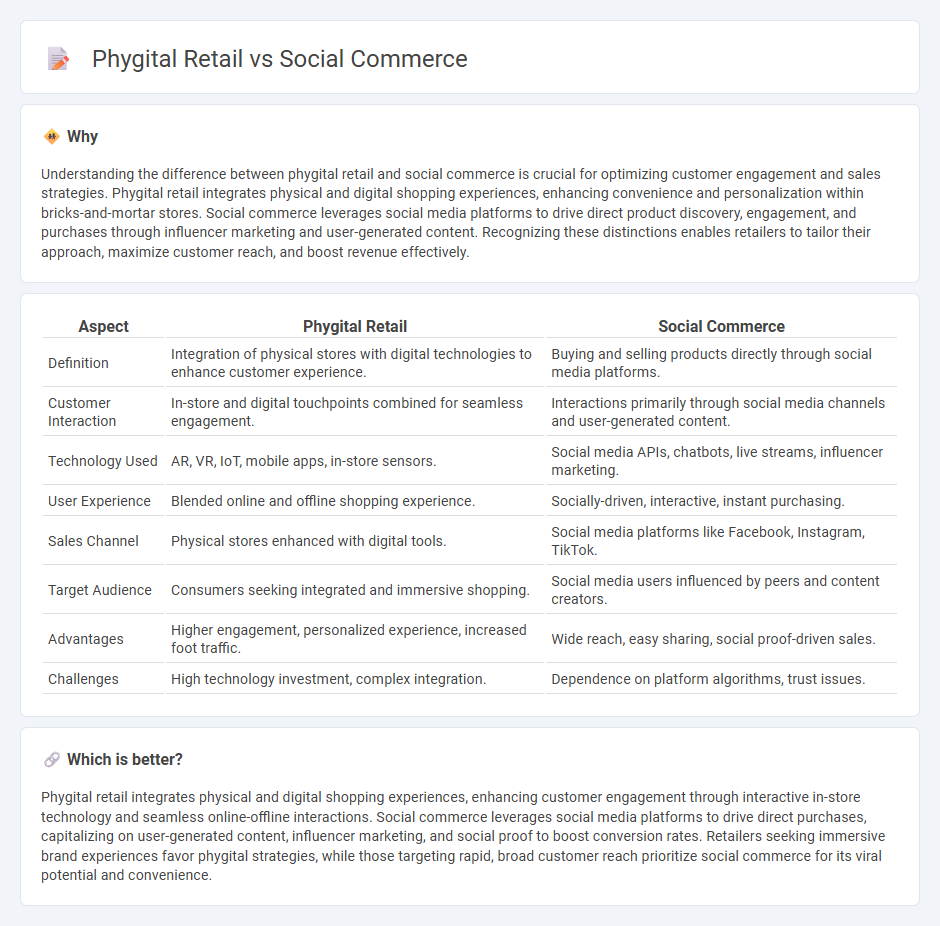
Phygital retail combines physical stores with digital technology to create seamless shopping experiences, integrating augmented reality, interactive displays, and mobile apps to engage customers both online and offline. Social commerce leverages social media platforms like Instagram, Facebook, and TikTok to facilitate direct purchases through shoppable posts, live streams, and influencer marketing. Explore how these innovative retail models are reshaping consumer behavior and driving sales growth.
Why it is important
Understanding the difference between phygital retail and social commerce is crucial for optimizing customer engagement and sales strategies. Phygital retail integrates physical and digital shopping experiences, enhancing convenience and personalization within bricks-and-mortar stores. Social commerce leverages social media platforms to drive direct product discovery, engagement, and purchases through influencer marketing and user-generated content. Recognizing these distinctions enables retailers to tailor their approach, maximize customer reach, and boost revenue effectively.
Comparison Table
| Aspect | Phygital Retail | Social Commerce |
|---|---|---|
| Definition | Integration of physical stores with digital technologies to enhance customer experience. | Buying and selling products directly through social media platforms. |
| Customer Interaction | In-store and digital touchpoints combined for seamless engagement. | Interactions primarily through social media channels and user-generated content. |
| Technology Used | AR, VR, IoT, mobile apps, in-store sensors. | Social media APIs, chatbots, live streams, influencer marketing. |
| User Experience | Blended online and offline shopping experience. | Socially-driven, interactive, instant purchasing. |
| Sales Channel | Physical stores enhanced with digital tools. | Social media platforms like Facebook, Instagram, TikTok. |
| Target Audience | Consumers seeking integrated and immersive shopping. | Social media users influenced by peers and content creators. |
| Advantages | Higher engagement, personalized experience, increased foot traffic. | Wide reach, easy sharing, social proof-driven sales. |
| Challenges | High technology investment, complex integration. | Dependence on platform algorithms, trust issues. |
Which is better?
Phygital retail integrates physical and digital shopping experiences, enhancing customer engagement through interactive in-store technology and seamless online-offline interactions. Social commerce leverages social media platforms to drive direct purchases, capitalizing on user-generated content, influencer marketing, and social proof to boost conversion rates. Retailers seeking immersive brand experiences favor phygital strategies, while those targeting rapid, broad customer reach prioritize social commerce for its viral potential and convenience.
Connection
Phygital retail integrates physical and digital shopping experiences, enhancing customer engagement through technology like AR and mobile apps, while social commerce leverages social media platforms to facilitate seamless online purchases. Both approaches focus on personalized, interactive customer journeys that blend offline and online touchpoints to boost sales and brand loyalty. The synergy of phygital retail and social commerce enables retailers to collect rich consumer data, optimize targeting strategies, and create immersive shopping environments that drive conversion rates.
Key Terms
User-Generated Content
Social commerce leverages User-Generated Content (UGC) to build trust and authenticity by showcasing real customer reviews, photos, and videos directly within online marketplaces and social platforms. Phygital retail integrates UGC by blending digital interactions with physical stores, using augmented reality and interactive displays to enhance customer engagement and personalized shopping experiences. Explore how UGC transforms purchasing behavior and drives innovation at the intersection of social commerce and phygital retail.
Omnichannel Experience
Social commerce leverages social media platforms to create seamless shopping experiences, integrating user engagement with direct purchases and personalized product recommendations. Phygital retail combines physical and digital environments, using technologies like augmented reality and in-store digital interfaces to enhance customer interaction and convenience. Discover how harnessing omnichannel strategies in both social commerce and phygital retail can elevate your brand's customer journey and boost sales.
Live Shopping
Live shopping integrates real-time video streams with ecommerce, boosting engagement and conversion rates through interactive product demonstrations. In contrast, phygital retail blends physical and digital experiences by merging in-store interaction with online convenience, enhancing customer immersion and satisfaction. Explore how live shopping is revolutionizing both social commerce and phygital strategies for deeper consumer connections.
Source and External Links
Social commerce - Wikipedia - Social commerce is the use of social networks in e-commerce transactions, allowing customers to browse and complete purchases without leaving social media platforms.
What is social commerce? - TechTarget - Social commerce leverages social media platforms like Facebook, Instagram, TikTok, and Pinterest to enable direct sales by integrating product marketing and checkout processes seamlessly within the social experience.
Social Commerce Examples: 16 Examples of Social Selling - Flowbox - Social commerce integrates shopping experiences into social interactions on platforms, using features like user reviews and social sharing to drive personalized and socially-driven sales journeys.
 dowidth.com
dowidth.com